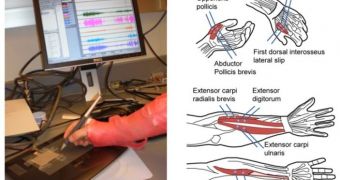Tired of typing endlessly on your computer keyboard, or sick of having to always cram your fingers on your smartphone's small screen? Then you may be happy to hear that neuroscientists from the Canton, New York-based Norconnect Inc., the Duke University, and the St. Lawrence University had you in mind when they started developing a new type of technology that will essentially allow you to type anything you want into thin air, without the need of any actual piece of hardware to input your data. The new system relies on analyzing brain waves and muscle-contraction patterns to infer exactly what you are trying to say, the team explains, quoted by Wired.
In a new paper, published in the August 26th issue of the open-access journal PLoS ONE, Norconnect Inc. neuroscientist Michael Linderman says exactly how the system will transform scribblings in the air into correct text input. Using a technique known as electromyography (EMG) – which analyzes and records the activation signals in muscles – as well as pattern-recognition algorithms, the science team managed to make their new technology able to convert electrical signals into their intended correspondent, be it a number or a letter.
The end-strife of this line of research, experts add, is the creation of a fingerless glove, outfitted with a large number of sensors that could analyze and interpret the way we move our hands and automatically generate text. “You can write in the air, can write on any surface, can write using a pen or pencil or even without, and this will be converted into text on the display of a cellphone or computer,” Linderman explains. In the journal entry, the scientists write about a series of experiments they conducted with six volunteers, in which the participants were asked to wear gloves that recorded the activity of eight muscle groups.
The test subjects wrote down numbers from one to nine fifty times each, with an average pen, while a computer analyzed the motion of their hand, and especially the action of the muscles in the arm and hand. The computer in charge of the recognition was then taught to recognize the electrical signals associated with each of the numbers, and eventually reproduce them in written language when the same signals came in, this time not from pens, but from motions executed in the air. “We wanted the system to be able to recognize those bursts of electricity as particular patterns associated with this type of mechanical activity,” Linderman adds.
“I think it’s a very solid piece of work. It’s something that they should in the future be able to use to as a way to electronically extract somebody’s handwriting based on recording the patterns of their muscle activity,” University of Arizona electrophysiology expert Andrew Fuglevand says. He has not been part of the new research, but has collaborated with Linderman in the past. DU Department of Neurobiology expert Mikhail A. Lebedev and SLU scientist Joseph S. Erlichman have also contributed to the innovation.

 14 DAY TRIAL //
14 DAY TRIAL //